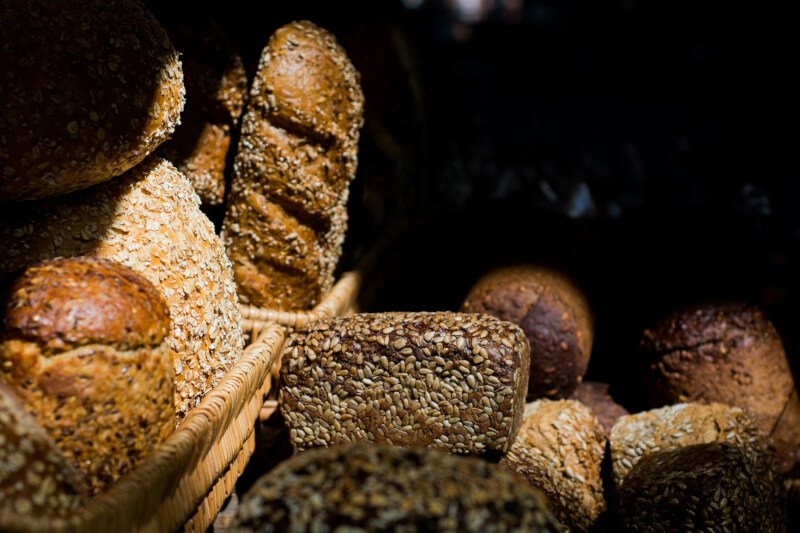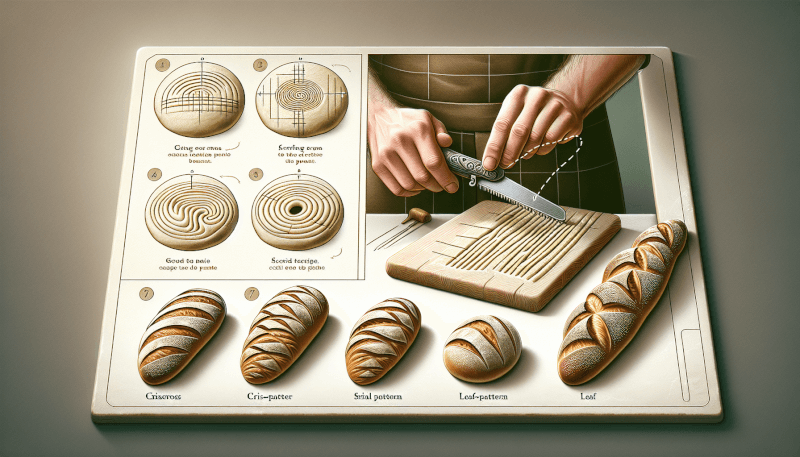In the world of artisan bread baking, the bread lame is an essential tool for achieving that perfect crust and beautiful scoring. But if you’re new to the world of bread baking, you may be wondering how to properly use this seemingly intimidating tool. Fear not! In this article, we’ll guide you through the steps of using a bread lame, from choosing the right blades to mastering the art of scoring. So grab your apron and get ready to elevate your bread baking game to new heights!

What is a Bread Lame?
Definition
A bread lame, pronounced “lahm,” is a tool used in artisan bread baking to create cuts, also known as scores, on the surface of the dough before it is baked. It consists of a handle with a removable blade, typically made of stainless steel. The word “lame” is derived from the French word for “blade.” The purpose of using a bread lame is to control the expansion of the dough during baking, creating a beautiful pattern on the crust and allowing the bread to rise evenly.
Purpose
The main purpose of scoring the dough with a bread lame is to control the direction in which the bread expands during baking. By making precise cuts, you influence how the dough will rise and prevent it from bursting in unwanted areas. Scoring also helps the crust to crack and release steam, resulting in a lighter, airier bread with a crisp crust. Additionally, scoring can be used as a decorative technique to create unique designs and patterns on the bread’s surface.
Choosing the Right Bread Lame
Types of Bread Lames
When it comes to choosing a bread lame, there are various types available on the market. The two most common types are the straight lame and the curved lame. A straight lame consists of a straight handle with a straight blade attachment, while a curved lame has a curved handle and a curved or curved/straight combination blade. Both types have their advantages and can be effective depending on personal preference and the desired scoring technique.
Considerations for Choosing
When selecting a bread lame, there are a few considerations to keep in mind. The first is the handle design. Look for a handle that feels comfortable in your hand and provides a secure grip. The balance between the handle and the blade is also essential for stability during scoring. Additionally, consider the blade’s quality and sharpness. It should be made of durable material and easy to replace when it becomes dull. Finally, take into account the price point and overall value of the bread lame when making your decision.
Preparing the Bread Lame
Cleaning and Sanitizing
Before using your bread lame, it is crucial to clean and sanitize it properly. Start by removing the blade from the handle if it is detachable. Use warm soapy water and a brush to clean both the blade and the handle thoroughly. Rinse them well under running water and pat them dry with a clean towel. To ensure proper sanitation, you can also use a food-safe sanitizer to eliminate any bacteria or residual yeast. Remember to follow the manufacturer’s recommendations for sanitizing your specific bread lame.
Blade Maintenance
To maintain the performance of your bread lame, it is crucial to take care of the blade. Regularly check the blade for any signs of rust or damage. If the blade begins to dull or shows signs of wear, it is time for a replacement. Many bread lames have blades that are easily removable, allowing for quick and convenient replacements. Keeping a spare blade on hand can ensure that you always have a sharp and reliable tool for scoring your bread.
Proper Holding and Grip
Correct Hand Placement
To effectively use a bread lame, it is important to hold it correctly. Place your dominant hand firmly around the handle, with your thumb resting on one side and your other four fingers on the opposite side. This grip should be comfortable and secure, allowing for precise control of the blade. Keep your hand relaxed and avoid gripping the handle too tightly, as this can affect the movement and stability of the lame during scoring.
Finding the Ideal Grip
Finding the ideal grip for your bread lame may require some experimentation. Each individual has different hand sizes and preferences, so it is important to find a grip that feels natural and comfortable for you. Adjusting the position of your hand on the handle or altering the angle at which you hold the blade can help achieve the best results. Practice scoring on a surface before attempting it on dough to familiarize yourself with different grips and find the one that works best for you.

Scoring Techniques
Basic Scoring Techniques
There are several basic scoring techniques that can be used with a bread lame. The most common technique is the single straight slash, which involves making a single, swift cut down the center of the dough. This technique allows for controlled expansion and is suitable for most bread recipes. Another basic technique is the cross slash, where two diagonal cuts are made to form an “X” shape on the surface of the dough. This technique is often used for baguettes or round loaves.
Advanced Scoring Techniques
For those looking to take their bread scoring skills to the next level, there are various advanced techniques to explore. These include the diamond pattern, where diagonal cuts are made in a crisscross manner, creating a diamond-like pattern on the dough’s surface. The leaf pattern involves making curved or S-shaped cuts on the dough to mimic the shape of leaves. The possibilities are endless, and with practice, you can develop your own unique scoring techniques and designs to enhance the aesthetics of your bread.
Understanding the Dough
Determining Dough Consistency
Before scoring the dough, it is important to understand its consistency. The hydration level of the dough, which refers to the amount of water relative to the amount of flour, plays a significant role in how it will behave during baking. A wetter dough will require fewer and shallower scores, as it will expand more readily. Conversely, a drier dough may require deeper and more numerous scores to allow for proper expansion. By understanding the dough’s consistency, you can adjust your scoring technique accordingly.
Factors to Consider
In addition to dough consistency, there are other factors to consider when scoring. The fermentation stage, proofing time, and type of bread being made can all influence how the dough reacts to scoring. A well-fermented dough with a longer proofing time will generally have more air bubbles, requiring careful scoring to prevent deflation. Additionally, different types of bread, such as ciabatta or sourdough, may have specific requirements for scoring techniques to achieve their desired characteristics. Pay attention to these factors and adapt your scoring approach accordingly for optimal results.

Scoring Patterns and Designs
Choosing Scoring Patterns
Choosing the right scoring pattern for your bread depends on personal preference, recipe, and aesthetic goals. Traditional patterns like the batard or baguette scoring patterns are suitable for everyday loaves and create an attractive artisan look. Experimenting with different patterns, such as intricate geometric designs or personal motifs, can add a creative touch to your bread. It is essential to keep in mind the loaf’s size, shape, and hydration level when selecting a scoring pattern to ensure it will expand properly during baking.
Creating Artistic Designs
Scoring bread can also be seen as an artistic expression. By using a bread lame, you can create unique designs and add a personal touch to your baked goods. Some bakers prefer to plan and sketch their designs on paper before scoring the dough, while others prefer to let their creativity flow in the moment. Whichever approach you choose, remember to have fun and embrace the artistic freedom that bread scoring offers. With practice and experimentation, you can develop your own signature scoring style.
Scoring for Optimal Oven Spring
Effect of Scoring on Oven Spring
Oven spring refers to the final burst of rising that occurs during the initial stages of baking when the dough is exposed to the high heat of the oven. Proper scoring plays a crucial role in achieving optimal oven spring. The cuts made with a bread lame allow trapped gases in the dough to escape, providing room for expansion. If the scoring is too shallow or insufficient, the bread may not rise as much, resulting in a denser loaf. On the other hand, if the scoring is too deep or excessive, the bread may collapse or develop an uneven shape.
Scoring Techniques to Maximize Growth
To maximize oven spring, it is important to use scoring techniques that encourage optimal expansion. One effective technique is the long, deep slash. This involves making a long, deep cut along the length of the loaf, allowing the dough to expand and bloom. Another technique is the ear score, which involves making a small perpendicular cut at the base of the loaf to create an “ear” or a raised section during baking. Experimenting with different scoring techniques and understanding how they affect oven spring will help you achieve the desired results.

Troubleshooting Common Issues
Uneven Scoring
Uneven scoring can occur when the cuts made on the dough vary in depth or length. This can result in uneven expansion during baking, leading to misshapen or lopsided loaves. To avoid this issue, ensure that the blade of your bread lame is properly aligned and that your hand movements are consistent. Practice making clean, swift cuts in one continuous motion. Pay attention to each cut, assessing its depth and length, and make adjustments as necessary. With practice, you will develop a more even scoring technique and achieve more consistent results.
Lame Dragging
Lame dragging refers to the blade getting caught or dragged along the dough’s surface as you make a cut. This can cause the dough to tear or drag, resulting in a less defined score. To prevent this, make sure your blade is sharp and clean. A dull or dirty blade can cause resistance, leading to lame dragging. Additionally, ensure that you are holding the handle of the bread lame securely and maintaining a stable grip. Make swift, confident cuts without hesitation to minimize the chances of lame dragging.
Care and Storage
Proper Lame Storage
To prolong the life of your bread lame, proper storage is essential. After each use, clean the blade and handle thoroughly, ensuring that no dough or flour residue remains. Allow them to air dry completely before reassembling the bread lame. Store the bread lame in a dry, cool place, away from moisture or direct sunlight. Some bread lames come with protective covers or sheaths for safe storage. Utilize these if available to prevent accidental injuries and maintain the blade’s sharpness.
Replacing Blades
Over time, the blade of your bread lame will become dull and less effective. It is important to replace the blade when it shows signs of wear or is no longer sharp enough to make clean cuts. Most bread lames have easily replaceable blades, allowing you to continue using the same handle. When replacing the blade, follow the manufacturer’s instructions and exercise caution to avoid any accidental injuries. Having spare blades on hand will ensure that you can always maintain the quality of your scoring and achieve the best results.
In conclusion, a bread lame is a valuable tool for any artisan bread baker. By understanding its purpose, choosing the right bread lame, preparing it properly, mastering proper hand placement and grip, exploring various scoring techniques, understanding the dough, and experimenting with patterns and designs, you can create beautifully scored loaves with optimal oven spring. Troubleshooting common issues and properly caring for your bread lame will ensure its longevity and continued performance. So, embrace the art of bread scoring with a bread lame and elevate your baking to new heights of creativity and deliciousness. Happy baking!



